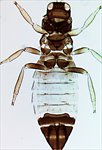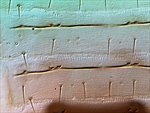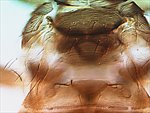Generic diagnosis
Female macropterous or micropterous. Head wider than long; ocellar setae pair I present, three pairs of postocular setae; maxillary palps 3-segmented. Antennae 8-segmented, segment I without paired dorso-apical setae, III and IV with sense-cones forked; III–VI with microtrichial rows on both surfaces. Pronotum wider than long with median blotch; one pair of long posteroangular setae. Mesonotum median pair of setae near middle; anteromedian campaniform sensilla absent. Metanotum with transverse striae and bearing rows of microtrichia; median pair of setae behind anterior margin; campaniform sensilla absent. Fore wings with first vein setal row complete; second vein with 0–2 distal setae; clavus with four veinal and one discal setae, posteromarginal fringe cilia wavy. Prosternal ferna undivided; basantra membranous and without setae. Mesosternal endofurca with spinula; metasternal endofurca without spinula; metasternal internal plate with anterior margin transverse to slightly concave. Legs fully covered with microtrichia, tarsi 2-segmented. Tergites entirely covered with microtrichial rows, without ctenidia, postero-marginal craspedum present; with four pairs of stout discal setae in transverse row (rarely as in kaszabi with setae S3 arising on or close to posterior margin); VIII with complete comb on posterior margin; IX without anterior campaniform sensilla, with more than one pair MD setae; X without median split. Sternites with covered with microtrichial rows, without discal setae; craspedum present; sternites III–VII with 3 pairs of posteromarginal setae, II with 2 pairs; VII with all setae in front of posterior margin.
Male similar to female but smaller, abdominal sternites IV–VII with pore plate.
Biological data
The species in this genus appear to be associated with the foliage of species of Fabaceae.
Distribution data
The species in this genus appear to be restricted to the northern hemisphere temperate zone (Lima & Mound, 2016b). The synonymy of two species described from China is given by Evdokarova & Vierbergen (2018), and Mirab-balou et al. (2013) indicated that an earlier record of the North American species cingulatus was based on a misidentification.
Nomenclatural data
Sericothrips Haliday, 1836: 83. Type species Sericothrips staphylinus Haliday, 1836, by monotypy.
This genus comprises eight species (ThripsWiki, 2020), but only one is known from China:
kaszabi Pelikan, 1984: 112.
Relationship data
Thripidae sub-family Sericothripinae: Sericothrips is one of only three genera now recognised in this group (Lima & Mound, 2016a). In contrast, more than 10 further genera have been proposed in the group but are now placed in synonymy (ThripsWiki, 2020). Species of Sericothrips differ from those in the other two genera in exhibiting character states associated with wing reduction, particularly the complete microtrichial cover of the abdominal tergites.
References
Evdokarova TG & Vierbergen G (2018) The first record of Sericothrips kaszabi Pelikan, 1984 (Thysanoptera, Thripidae) from Russia. Entomological Review 98 (2): 192–196.
Lima EFB & Mound LA (2016a) Systematic relationships of the Thripidae subfamily Sericothripinae (Insecta: Thysanoptera). Zoologischer Anzeiger 263: 24–32.
Mirab-balou M, Minoura K & Tong XL (2013) A new synonym of Sericothrips from China & Japan (Thysanoptera: Thripidae). Zootaxa 3620 (3): 481–482.
Lima EFB & Mound LA (2016b) Species-richness in Neotropical Sericothripinae (Thysanoptera: Thripidae) Zootaxa 4162 (1): 1–45.
ThripsWiki (2020) ThripsWiki - providing information on the World's thrips. <http://thrips.info/wiki/Main_Page>


